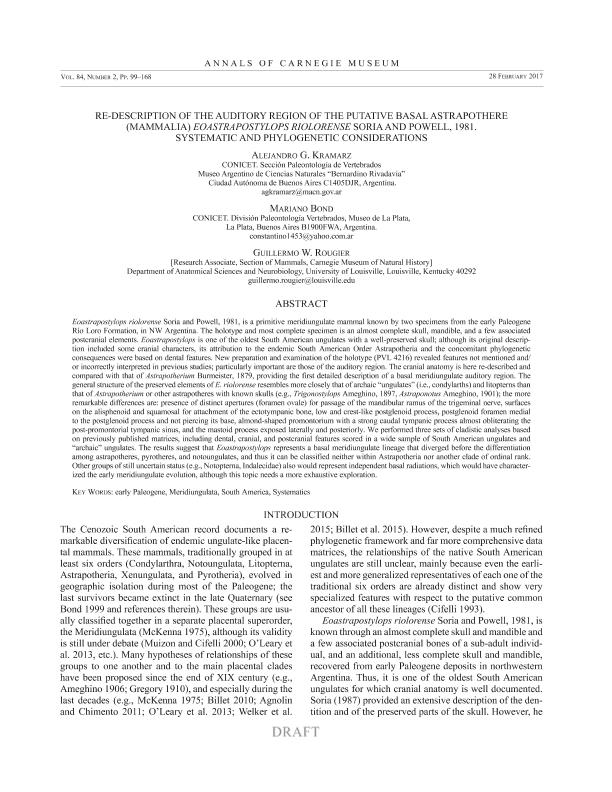Mostrar el registro sencillo del ítem
dc.contributor.author
Kramarz, Alejandro Gustavo

dc.contributor.author
Bond, Mariano

dc.contributor.author
Rougier, Guillermo Walter

dc.date.available
2018-06-07T21:46:13Z
dc.date.issued
2017-03
dc.identifier.citation
Kramarz, Alejandro Gustavo; Bond, Mariano; Rougier, Guillermo Walter; Re-Description of the Auditory Region of the Putative Basal Astrapothere (Mammalia) Eoastrapostylops riolorense Soria and Powell, 1981. Systematic and Phylogenetic Considerations; Carnegie Museum Natural History; Annals Of Carnegie Museum; 84; 2; 3-2017; 95-164
dc.identifier.issn
0097-4463
dc.identifier.uri
http://hdl.handle.net/11336/47823
dc.description.abstract
Eoastrapostylops riolorense Soria and Powell, 1981, is a primitive meridiungulate mammal known by two specimens from the early Paleogene Río Loro Formation, in NW Argentina. The holotype and most complete specimen is an almost complete skull, mandible, and a few associated postcranial elements. Eoastrapostylops is one of the oldest South American ungulates with a well-preserved skull; although its original description included some cranial characters, its attribution to the endemic South American Order Astrapotheria and the concomitant phylogenetic consequences were based on dental features. New preparation and examination of the holotype (PVL 4216) revealed features not mentioned and/ or incorrectly interpreted in previous studies; particularly important are those of the auditory region. The cranial anatomy is here re-described and compared with that of Astrapotherium Burmeister, 1879, providing the first detailed description of a basal meridiungulate auditory region. The general structure of the preserved elements of E. riolorense resembles more closely that of archaic “ungulates” (i.e., condylarths) and litopterns than that of Astrapotherium or other astrapotheres with known skulls (e.g., Trigonostylops Ameghino, 1897, Astraponotus Ameghino, 1901); the more remarkable differences are: presence of distinct apertures (foramen ovale) for passage of the mandibular ramus of the trigeminal nerve, surfaces on the alisphenoid and squamosal for attachment of the ectotympanic bone, low and crest-like postglenoid process, postglenoid foramen medial to the postglenoid process and not piercing its base, almond-shaped promontorium with a strong caudal tympanic process almost obliterating the post-promontorial tympanic sinus, and the mastoid process exposed laterally and posteriorly. We performed three sets of cladistic analyses based on previously published matrices, including dental, cranial, and postcranial features scored in a wide sample of South American ungulates and “archaic” ungulates. The results suggest that Eoastrapostylops represents a basal meridiungulate lineage that diverged before the differentiation among astrapotheres, pyrotheres, and notoungulates, and thus it can be classified neither within Astrapotheria nor another clade of ordinal rank. Other groups of still uncertain status (e.g., Notopterna, Indalecidae) also would represent independent basal radiations, which would have characterized the early meridiungulate evolution, although this topic needs a more exhaustive exploration.
dc.format
application/pdf
dc.language.iso
eng
dc.publisher
Carnegie Museum Natural History

dc.rights
info:eu-repo/semantics/openAccess
dc.rights.uri
https://creativecommons.org/licenses/by-nc-sa/2.5/ar/
dc.subject
Paleogene
dc.subject
Meridiungulata
dc.subject
Systematics
dc.subject
Eoastrapostylops
dc.subject.classification
Meteorología y Ciencias Atmosféricas

dc.subject.classification
Ciencias de la Tierra y relacionadas con el Medio Ambiente

dc.subject.classification
CIENCIAS NATURALES Y EXACTAS

dc.title
Re-Description of the Auditory Region of the Putative Basal Astrapothere (Mammalia) Eoastrapostylops riolorense Soria and Powell, 1981. Systematic and Phylogenetic Considerations
dc.type
info:eu-repo/semantics/article
dc.type
info:ar-repo/semantics/artículo
dc.type
info:eu-repo/semantics/publishedVersion
dc.date.updated
2018-06-04T17:04:56Z
dc.identifier.eissn
1943-6300
dc.journal.volume
84
dc.journal.number
2
dc.journal.pagination
95-164
dc.journal.pais
Estados Unidos

dc.journal.ciudad
Pittsburgh
dc.description.fil
Fil: Kramarz, Alejandro Gustavo. Consejo Nacional de Investigaciones Científicas y Técnicas. Oficina de Coordinación Administrativa Parque Centenario. Museo Argentino de Ciencias Naturales "Bernardino Rivadavia"; Argentina
dc.description.fil
Fil: Bond, Mariano. Universidad Nacional de La Plata. Facultad de Ciencias Naturales y Museo. División Paleontología Vertebrados; Argentina. Consejo Nacional de Investigaciones Científicas y Técnicas; Argentina
dc.description.fil
Fil: Rougier, Guillermo Walter. The University Of Louisville; Estados Unidos
dc.journal.title
Annals Of Carnegie Museum

dc.relation.alternativeid
info:eu-repo/semantics/altIdentifier/url/http://www.bioone.org/doi/abs/10.2992/007.084.0204
dc.relation.alternativeid
info:eu-repo/semantics/altIdentifier/doi/http://dx.doi.org/10.2992/007.084.0204
Archivos asociados
